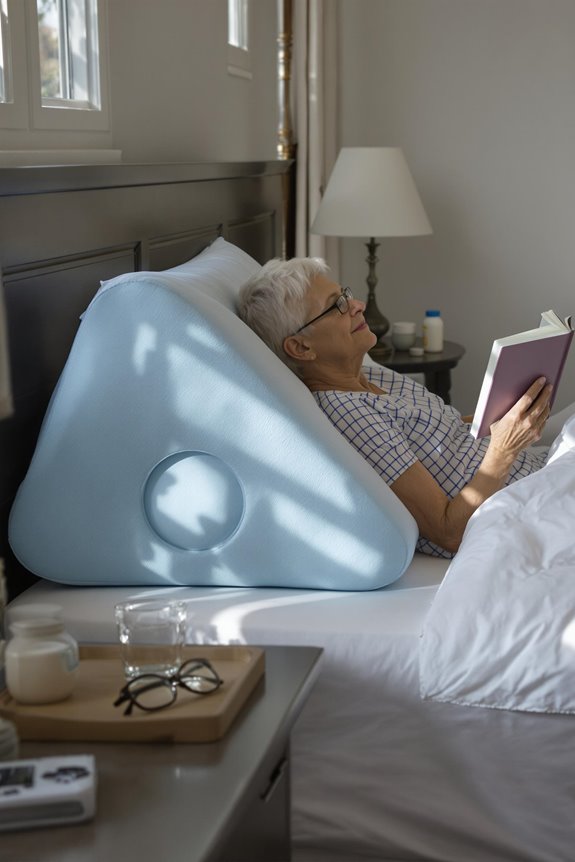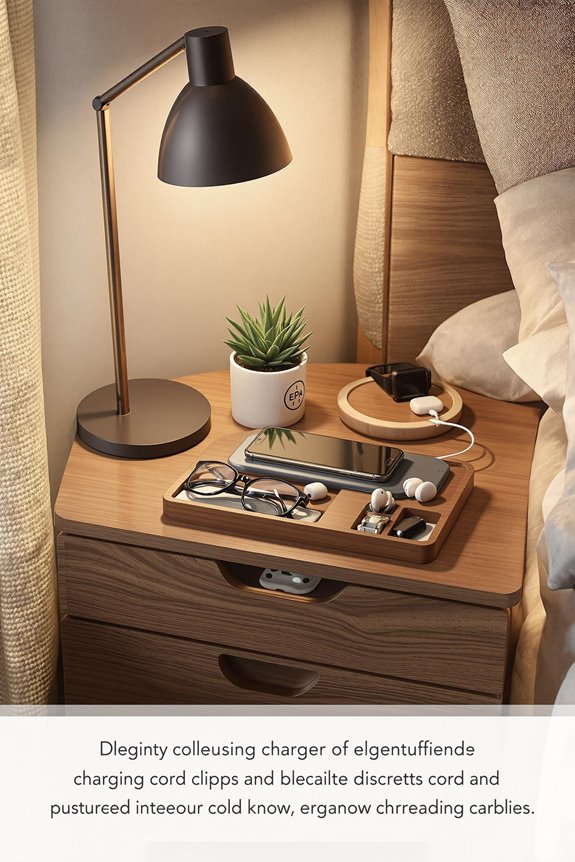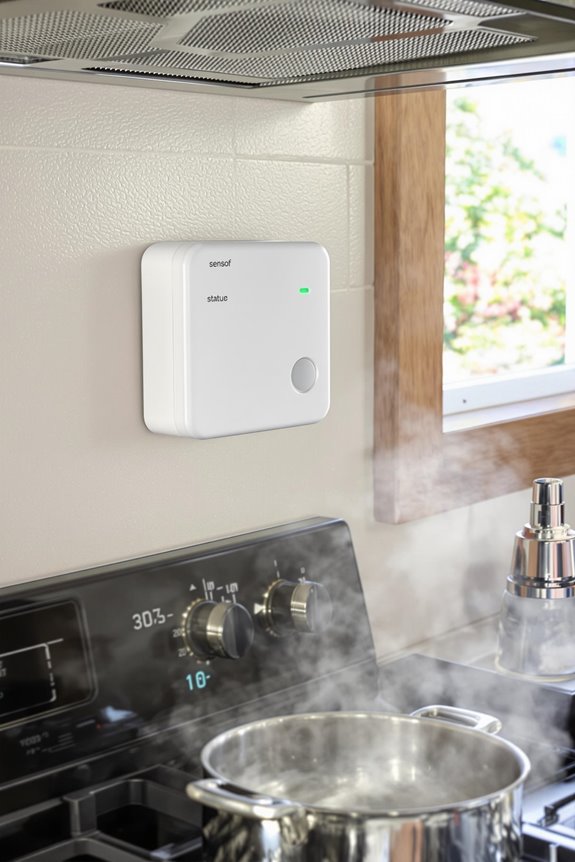You’ve probably experienced that sudden jolt of scalding water in the shower when someone flushes a toilet or turns on a faucet elsewhere in your home. Anti-scald mixing valves eliminate this common household hazard by maintaining consistent water temperatures regardless of pressure fluctuations. These simple devices blend hot and cold water before it reaches your faucet, protecting everyone in your household—especially children and seniors—from potential burns. But how do you select the right valve for your specific plumbing system?
Key Takeaways
- Anti-scald mixing valves automatically blend hot and cold water to maintain a consistent, safe temperature around 120°F.
- Once installed, these valves require minimal daily interaction while continuously protecting vulnerable users from scalding.
- They provide crucial protection for seniors, children, and individuals with mobility issues or decreased temperature sensitivity.
- Annual maintenance checks ensure proper functionality, particularly in homes with hard water.
- Installation options include whole-house protection at the water heater or targeted safety at individual high-risk fixtures.
Anti Scald Mixing Valves
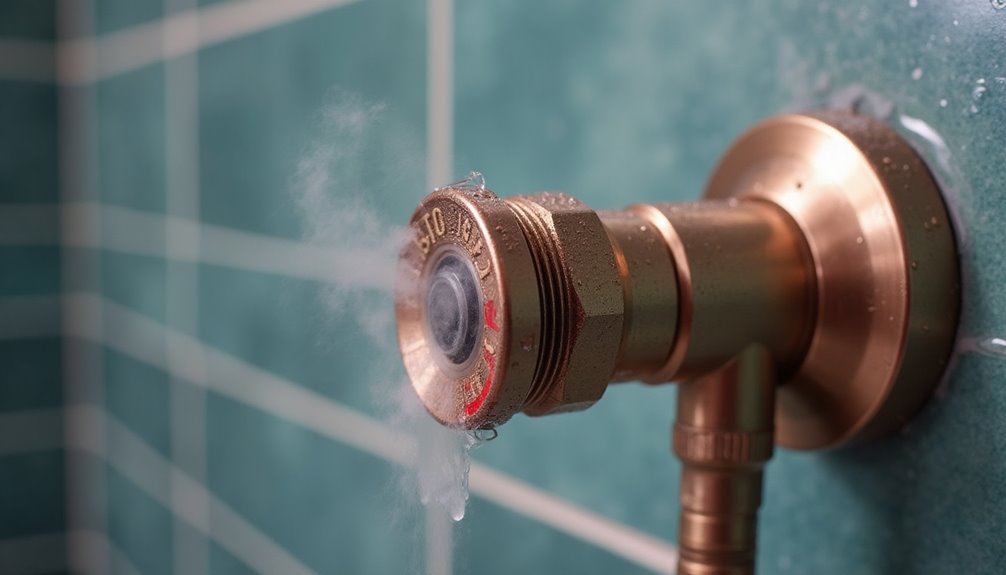
When it comes to preventing serious burns in your parent’s home, anti-scald mixing valves are one of the most important safety upgrades you can install.
These devices blend hot and cold water before it reaches the faucet or showerhead, maintaining a consistent, safe temperature regardless of pressure changes elsewhere in the home.
Anti-scald valves ensure water remains at safe temperatures despite household pressure fluctuations, protecting vulnerable users from unexpected burns.
For seniors aging in place, these valves provide vital protection since older adults often have thinner skin that burns more easily and may react more slowly to temperature changes.
Installation typically occurs at the water heater or directly beneath individual fixtures, creating an effective barrier against sudden scalding water that might occur when someone flushes a toilet or turns on an appliance elsewhere in the house, making them an essential component of thorough home safety planning.
What it is and the daily problems it solves
Safety innovation takes center stage with anti-scald mixing valves, which are specialized plumbing devices that constantly monitor and adjust water temperature before it reaches your parent’s faucets or showerheads.
These ingenious valves blend hot and cold water to maintain a consistent, safe temperature—typically around 120°F—preventing dangerous scalding accidents that can cause serious burns to aging skin.
For seniors with diminished sensitivity, slower reaction times, or mobility challenges, these valves eliminate the daily struggle of constantly adjusting faucets to find a comfortable temperature.
This technology contributes greatly to fall prevention by reducing instances where your loved one might jerk away from unexpectedly hot water, potentially losing balance.
The peace of mind comes from knowing the water temperature remains stable even when pressure fluctuates, such as when someone flushes a toilet or starts the dishwasher.
Who benefits and when to use it
Three key groups benefit most from anti-scald mixing valves in the home.
First, seniors with decreased sensitivity to temperature or slower reaction times gain essential protection against accidental burns.
Second, individuals with mobility challenges or balance issues benefit from accessibility improvements that eliminate the need to make temperature adjustments during bathing.
Third, families with young children find peace of mind knowing the water temperature remains consistently safe.
Install these valves when renovating bathrooms, updating plumbing systems, or making age-in-place modifications.
They’re particularly valuable after a near-miss scalding incident, when moving an elderly parent into your home, or when adapting a bathroom for someone with physical limitations.
Consider them essential when hot water heaters must be set at higher temperatures to accommodate medical equipment or dishwashers. Additionally, the installation of these valves can significantly enhance the quality of life for seniors by reducing the risk of burns and promoting safer bathing experiences.
Key features to look for
When selecting an anti-scald mixing valve, you’ll want to focus on specific features that guarantee both effectiveness and reliability for your parents’ home.
Shopping for these safety devices can feel overwhelming with so many options available, but knowing exactly what to look for simplifies the process.
Let’s review the essential features that make a quality anti-scald valve worth the investment.
Feature checklist
Shopping for anti-scald mixing valves can feel overwhelming with so many options available.
To help narrow down your choices, I’ve created this simple feature checklist that focuses on what matters most for seniors aging in place.
When evaluating mixing valves, look for these essential features:
- Easy temperature adjustment – Choose models with clearly marked controls that don’t require significant hand strength for installation or adjustments.
- Thermostatic protection – Confirm the valve maintains consistent temperatures even when water pressure fluctuates elsewhere in the home.
- Quality certification – Select valves certified by ASSE 1016, 1017, or 1070 standards to guarantee reliable performance and safety.
How to choose the right anti scald mixing valves
Selecting the right anti-scald mixing valve for your parents’ home requires careful consideration of several key factors that impact both safety and functionality.
When deciding how to choose, first determine whether you need a point-of-use valve for a single fixture or a whole-house system.
Next, check temperature range capabilities—look for valves that maintain consistent temperatures between 95-120°F.
Consider flow rate requirements based on household water usage patterns.
For Bergen County homes with our variable water pressure, select valves with pressure-balancing features.
Also evaluate installation requirements—some models are DIY-friendly while others require professional plumbing expertise.
Finally, verify certification standards. Look for ASSE 1016, 1017, or 1070 compliance to confirm the valve meets safety guidelines that protect seniors from potential scalding injuries.
Placement or installation basics
Three key placement decisions will determine the effectiveness of your anti-scald mixing valve installation.
First, consider installing at the water heater for whole-house protection or at individual fixtures for targeted safety.
Second, guarantee accessibility for future maintenance—avoid placement behind walls without access panels.
Finally, proper orientation matters—the valve must be installed in the correct flow direction with cold and hot water inputs properly connected. Most valves include directional arrows to guide installation.
When planning placement, remember:
- Check local plumbing codes for requirements
- Allow space for adjustment access
- Install temperature gauges before and after the valve
- Consider drain valve placement for system flushing
While DIY installation is possible for handy homeowners, I recommend professional installation for seniors’ homes to guarantee proper function and maximum safety.
Setup steps
Installing an anti-scald mixing valve correctly involves several important setup steps that guarantee your loved one’s safety and the valve’s proper function.
First, shut off the main water supply and drain the existing pipes. Next, carefully follow the manufacturer’s instructions to connect the valve between the hot and cold water lines leading to the fixture.
After installation, you’ll need to calibrate the valve to achieve the ideal temperature balance for comfort. This typically involves adjusting a dial or lever on the valve while testing the water temperature with a thermometer. Most experts recommend setting maximum temperatures between 100-120°F for seniors.
Once calibrated, secure all connections, restore water supply, and test the system thoroughly.
Remember that annual maintenance checks maintain continued protection, especially in areas with hard water that might affect valve performance.
Costs and warranties

When planning for an anti-scald mixing valve installation, you’ll want to set aside a reasonable budget for both the equipment and professional installation.
Most homeowners can expect to spend between $150-$350 for a quality valve, plus an additional $200-$400 for professional installation if you don’t tackle it yourself.
Understanding your budget constraints upfront helps guarantee you’re not surprised by costs while still getting the safety features your loved ones need.
Example budget
The financial investment for anti-scald mixing valves varies widely depending on quality, features, and installation requirements. For the best protection of your loved ones, I recommend budgeting appropriately to guarantee you’re getting reliable equipment that will last for years.
Here’s a breakdown of what you might expect to spend:
| Item | Price Range | Notes |
|---|---|---|
| Basic valve | $25-$75 | Point-of-use protection |
| Premium valve | $75-$150 | Whole-bathroom coverage |
| Professional installation | $150-$300 | Includes testing and calibration |
| Permits (if required) | $50-$100 | Varies by municipality |
| Annual maintenance | $0-$50 | DIY or professional inspection |
Remember that investing in quality now often saves money in the long run through improved durability and fewer replacement costs.
Daily use and upkeep
After installing an anti-scald mixing valve, you’ll find that daily operation becomes quite straightforward for your parents.
The beauty of these devices is that they require virtually no regular interaction once properly set to the safe temperature range for seniors.
Unlike traditional faucets that need constant adjustment, anti-scald valves maintain consistent water temperature regardless of pressure changes elsewhere in the home. Your parents won’t need to worry about sudden temperature spikes when someone flushes a toilet or starts the dishwasher.
Maintenance is minimal—just schedule an annual inspection to verify the valve continues functioning properly.
Have a plumber check for mineral buildup in hard water areas, which can occasionally affect performance.
Otherwise, these devices truly offer “set it and forget it” protection, giving both you and your parents valuable peace of mind.
Safety tips and mistakes to avoid
Safety becomes paramount when installing and using anti-scald mixing valves, with several critical mistakes commonly appearing during the process. Many homeowners set temperatures too high, defeating the valve’s purpose, or attempt DIY installations without proper knowledge.
Anti-scald valves must be correctly installed and maintained to protect against dangerous burn risks—never cut corners on this essential safety device.
Always hire a licensed plumber for installation and annual inspections.
Key safety tips include:
- Never bypass regular maintenance checks
- Don’t ignore valve manufacturer temperature recommendations
- Avoid forcing valve adjustments when resistance is felt
- Remember that mixing valves complement, not replace, water heater maintenance
A common mistake is assuming one valve installation protects your entire home. For thorough protection, consider individual valves at each high-risk fixture.
When working with elderly parents, verify water temperature with a reliable thermometer before allowing shower or bath use, regardless of valve installation.
Alternatives and when not to use this product
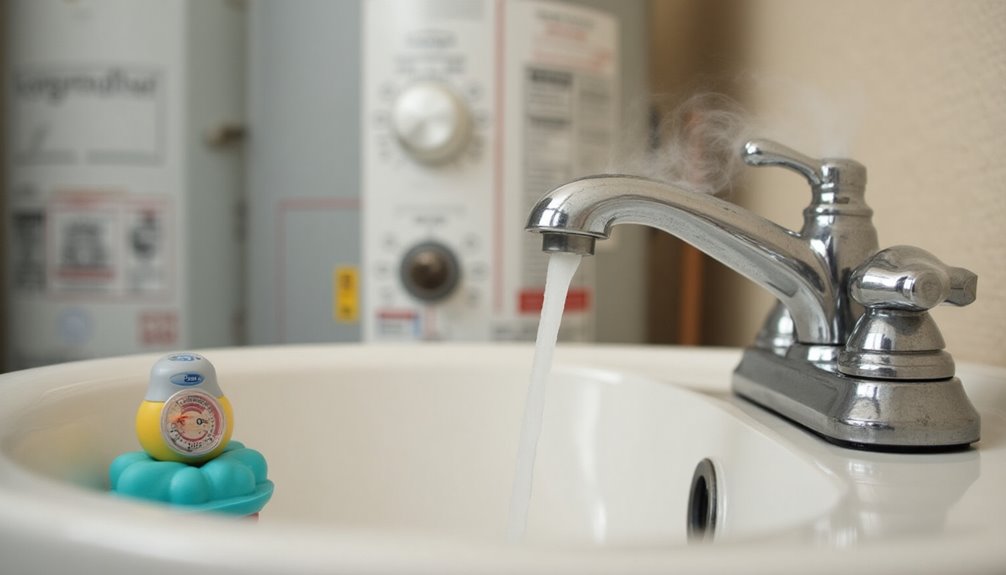
While anti-scald mixing valves provide excellent protection for most households, they aren’t always the ideal solution for every situation.
If you’re looking for alternatives, consider point-of-use temperature regulators that attach directly to specific faucets rather than controlling your entire system.
Some homes with specialized plumbing configurations may not accommodate standard mixing valves, particularly older homes with unusual pipe layouts or materials.
In these cases, consult with a licensed plumber before installation.
Remember these tips: mixing valves aren’t recommended for systems already equipped with advanced temperature regulation features, as they may interfere with existing controls.
They’re also unnecessary in homes with modern tankless water heaters that provide precise temperature control through their built-in programming.
Always prioritize professional assessment before making changes to any water heating system used by seniors.
FAQs
Let’s address some common questions I regularly hear from families looking to install anti-scald mixing valves for their senior loved ones.
How much does installation cost?
Typically, you’ll spend $150-300 for the valve plus professional installation, though prices vary throughout Bergen County depending on your plumbing configuration.
Do I need one for every faucet?
Ideally yes, but start with showers and tubs where scalding risks are highest.
Will this affect water pressure?
Quality valves maintain good pressure while regulating temperature.
How long do they last?
Most valves perform reliably for 5-7 years before needing inspection or replacement.
Can I install it myself?
While possible, I recommend professional installation to guarantee proper function and maximum safety benefits.
Frequently Asked Questions
Can Installing an Anti-Scald Valve Affect My Water Pressure?
Anti-scald valves typically won’t affect your water pressure if properly installed. They regulate temperature, not flow rate, though some budget models might cause a slight reduction.
If you notice decreased pressure after installation, check for proper sizing—the valve should match your pipe diameter. Also verify there’s no debris trapped inside the valve.
Most homeowners find that professional installation guarantees peak performance without compromising your regular water pressure.
Do I Need to Hire a Plumber or Can I Install It Myself?
While some DIY-savvy homeowners can install anti-scald valves, I typically recommend hiring a licensed plumber.
The installation involves cutting into water lines and precise calibration to guarantee proper temperature control. Mistakes can lead to leaks or improper function, potentially compromising your parent’s safety.
If you’re experienced with plumbing projects and have the proper tools, you could attempt it, but professional installation assures proper functioning and often includes a warranty.
How Often Should Anti-Scald Valves Be Tested or Replaced?
Test your anti-scald valve annually by checking water temperature with a thermometer to verify it’s below 120°F.
Most manufacturers recommend replacing valves every 3-5 years, though high-quality models may last longer.
Watch for warning signs like temperature fluctuations, mineral buildup, or leaking.
Regular maintenance extends valve life and keeps your loved ones safe.
Mark your calendar for yearly checks, and consider professional inspection if you notice any performance issues.
Will an Anti-Scald Valve Interfere With My Tankless Water Heater?
No, an anti-scald valve won’t interfere with your tankless water heater—they actually work well together.
The valve is installed after the water heater and simply regulates the maximum temperature of water reaching your faucets.
Your tankless system will still operate efficiently, heating water on demand, while the anti-scald valve provides that vital layer of safety by preventing dangerous temperature spikes that could harm sensitive skin.
Are There Any Rebates Available for Senior Safety Bathroom Modifications?
Yes, several rebate options exist for senior bathroom safety modifications.
Medicare Advantage plans often cover bathroom grab bars and walk-in tubs.
New Jersey’s CAPP program offers grants up to $10,000 for accessibility improvements.
Additionally, check for tax deductions through the Medical Expense Tax Credit and explore Bergen County’s home modification assistance programs.
Contact your local Office on Aging for a complete list of financial aid opportunities tailored to seniors.
Bottom Line
You’ve now learned how anti-scald mixing valves provide consistent water temperature protection for your entire household. By investing in this simple device, you’ll safeguard vulnerable family members from potential burns while enjoying reliable water temperatures regardless of pressure fluctuations. Remember to select valves that meet your specific needs, maintain them properly, and consult a professional for installation if needed. Your family’s safety is worth this straightforward plumbing upgrade.

